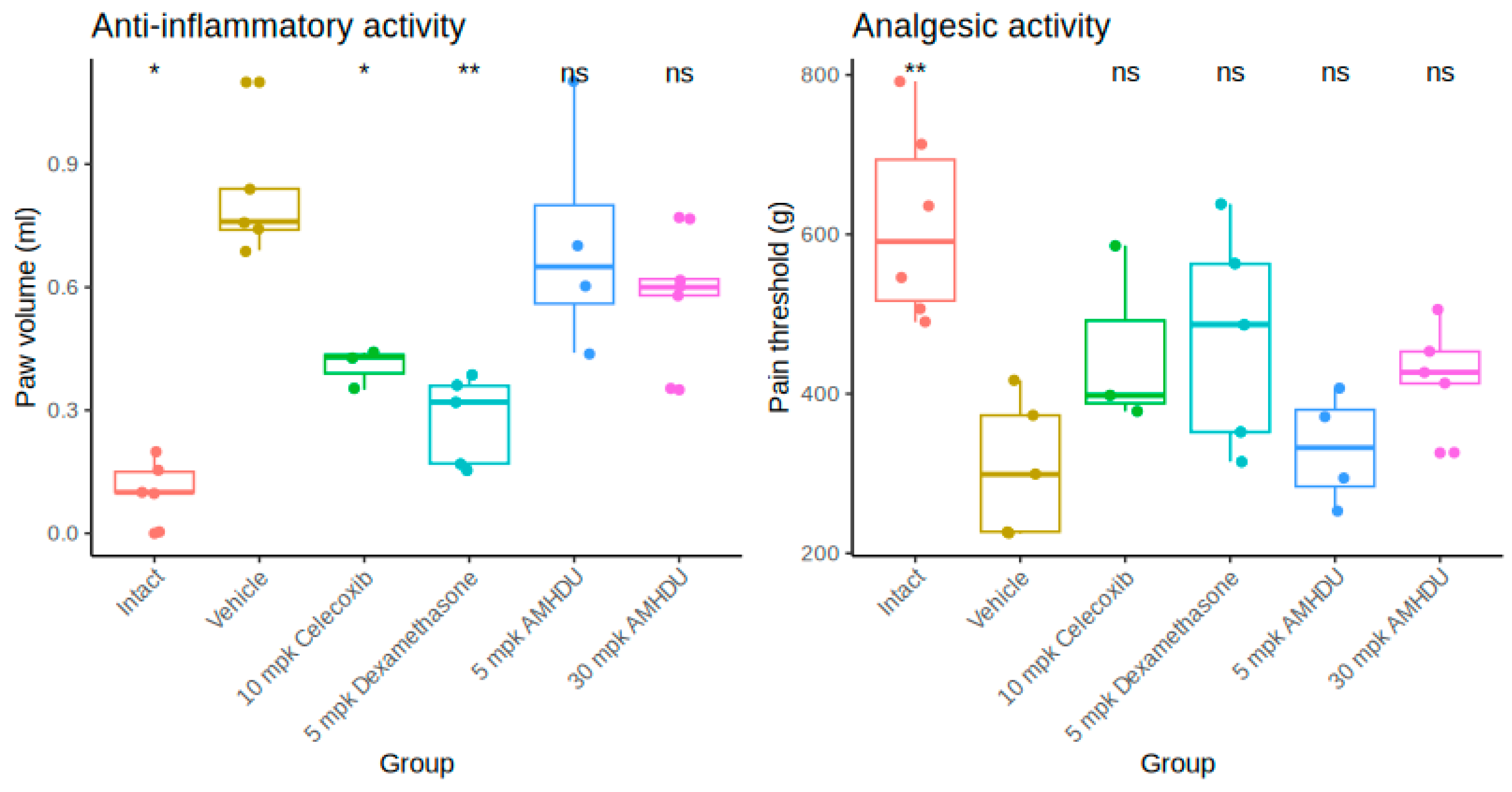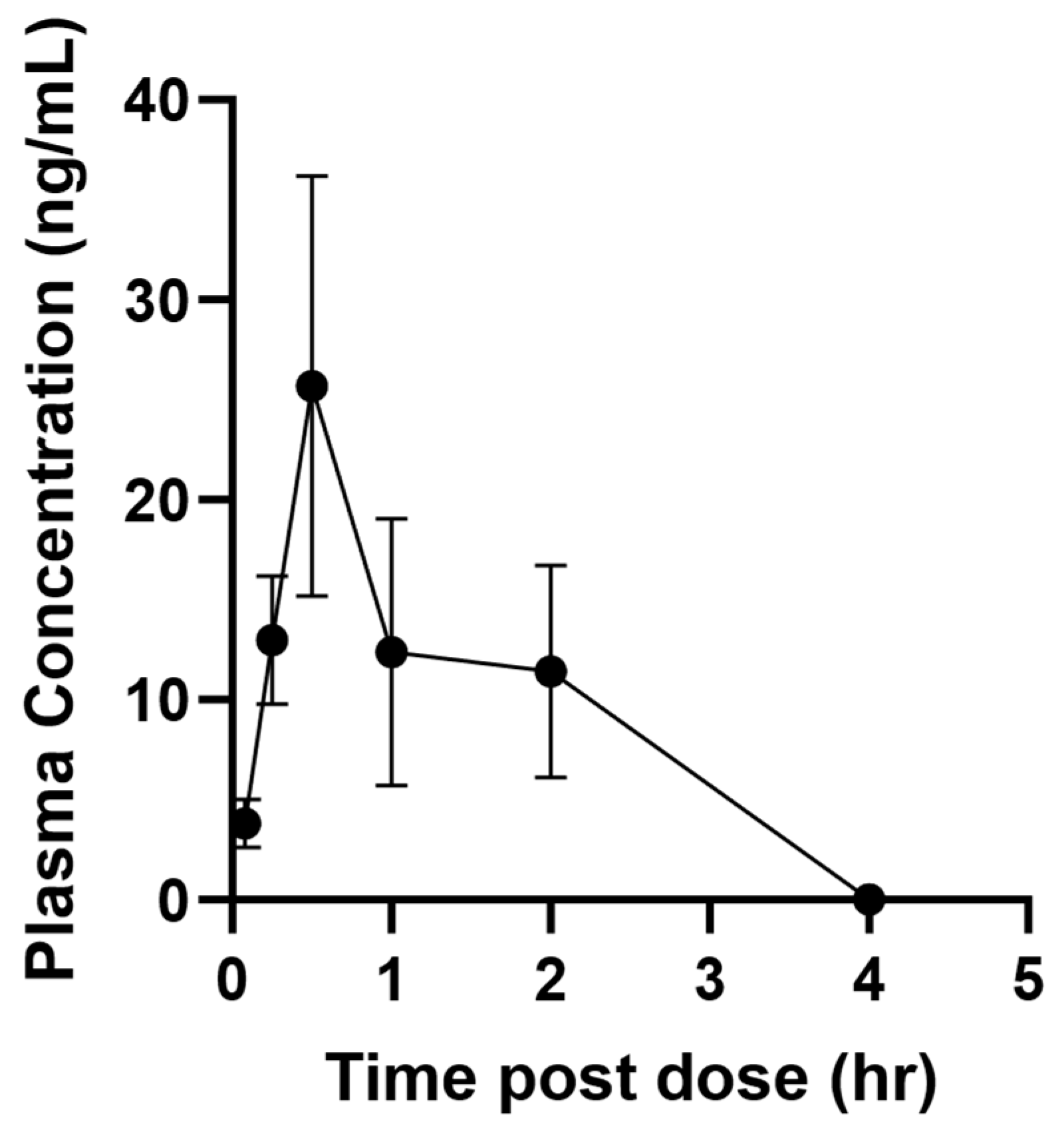Preclinical Evaluation of Soluble Epoxide Hydrolase Inhibitor AMHDU against Neuropathic Pain
Abstract
:1. Introduction
2. Results
2.1. Anti-Inflammatory and Analgesic Activity
2.2. Pharmacokinetics Nature of the Molecule
2.3. Acute Oral Toxicity Results
3. Discussion
4. Materials and Methods
4.1. General
4.2. Anti-Inflammatory and Analgesic Activity Study
4.3. Tactile Allodynia Evaluation
4.4. Pharmacokinetic Study
4.5. Acute Oral Toxicity Study
4.6. Data Analysis and Statistics
5. Conclusions
Author Contributions
Funding
Institutional Review Board Statement
Informed Consent Statement
Data Availability Statement
Conflicts of Interest
References
- Baskozos, G.; Hébert, H.L.; Pascal, M.M.V.; Themistocleous, A.C.; Macfarlane, G.J.; Wynick, D.; Bennett, D.L.H.; Smith, B.H. Epidemiology of Neuropathic Pain: An Analysis of Prevalence and Associated Factors in UK Biobank. Pain Rep. 2023, 8, e1066. [Google Scholar] [CrossRef] [PubMed]
- Dermanovic Dobrota, V.; Hrabac, P.; Skegro, D.; Smiljanic, R.; Dobrota, S.; Prkacin, I.; Brkljacic, N.; Peros, K.; Tomic, M.; Lukinovic-Skudar, V.; et al. The Impact of Neuropathic Pain and Other Comorbidities on the Quality of Life in Patients with Diabetes. Health Qual. Life Outcomes 2014, 12, 171. [Google Scholar] [CrossRef] [PubMed]
- Inoue, S.; Taguchi, T.; Yamashita, T.; Nakamura, M.; Ushida, T. The Prevalence and Impact of Chronic Neuropathic Pain on Daily and Social Life: A Nationwide Study in a Japanese Population. Eur. J. Pain 2017, 21, 727–737. [Google Scholar] [CrossRef]
- Smith, B.H.; Torrance, N. Epidemiology of Neuropathic Pain and Its Impact on Quality of Life. Curr. Pain Headache Rep. 2012, 16, 191–198. [Google Scholar] [CrossRef] [PubMed]
- Martins, I.; Golden, J.P.; Neto, F.L. Editorial: Women in Science: Neuropathic Pain. Front. Pain Res. 2023, 4, 1273636. [Google Scholar] [CrossRef]
- Wagner, K.M.; McReynolds, C.B.; Schmidt, W.K.; Hammock, B.D. Soluble Epoxide Hydrolase as a Therapeutic Target for Pain, Inflammatory and Neurodegenerative Diseases. Pharmacol. Ther. 2017, 180, 62–76. [Google Scholar] [CrossRef]
- Wagner, K.; Yang, J.; Inceoglu, B.; Hammock, B.D. Soluble Epoxide Hydrolase Inhibition Is Antinociceptive in a Mouse Model of Diabetic Neuropathy. J. Pain 2014, 15, 907–914. [Google Scholar] [CrossRef] [PubMed]
- Wang, Y.; Wagner, K.M.; Morisseau, C.; Hammock, B.D. Inhibition of the Soluble Epoxide Hydrolase as an Analgesic Strategy: A Review of Preclinical Evidence. J. Pain Res. 2021, 14, 61–72. [Google Scholar] [CrossRef]
- Anita, N.Z.; Swardfager, W. Soluble Epoxide Hydrolase and Diabetes Complications. Int. J. Mol. Sci. 2022, 23, 6232. [Google Scholar] [CrossRef]
- Hammock, B.D.; McReynolds, C.B.; Wagner, K.; Buckpitt, A.; Cortes-Puch, I.; Croston, G.; Lee, K.S.S.; Yang, J.; Schmidt, W.K.; Hwang, S.H. Movement to the Clinic of Soluble Epoxide Hydrolase Inhibitor EC5026 as an Analgesic for Neuropathic Pain and for Use as a Nonaddictive Opioid Alternative. J. Med. Chem. 2021, 64, 1856–1872. [Google Scholar] [CrossRef]
- Kundu, B.; Dvorácskó, S.; Basu, A.; Pommerolle, L.; Kim, K.A.; Wood, C.M.; Gibbs, E.; Behee, M.; Tarasova, N.I.; Cinar, R.; et al. Evaluation of the Therapeutic Potential of Sulfonyl Urea Derivatives as Soluble Epoxide Hydrolase (sEH) Inhibitors. Molecules 2024, 29, 3036. [Google Scholar] [CrossRef] [PubMed]
- Kong, L.; Li, J.; Bai, Y.; Xu, S.; Zhang, L.; Chen, W.; Gao, L.; Wang, F. Inhibition of soluble epoxide hydrolase enhances the dentin-pulp complex regeneration mediated by crosstalk between vascular endothelial cells and dental pulp stem cells. J. Transl. Med. 2024, 22, 61. [Google Scholar] [CrossRef] [PubMed]
- Griñán-Ferré, C.; Jarné-Ferrer, J.; Bellver-Sanchís, A.; Codony, S.; Puigoriol-Illamola, D.; Sanfeliu, C.; Oh, Y.; Lee, S.; Vázquez, S.; Pallàs, M. Novel Molecular Mechanism Driving Neuroprotection after Soluble Epoxide Hydrolase Inhibition: Insights for Alzheimer’s Disease Therapeutics. CNS Neurosci. Ther. 2023, 30, e14511. [Google Scholar] [CrossRef] [PubMed]
- Verma, K.; Jain, S.; Paliwal, S.; Paliwal, S.; Sharma, S. A Clinical Perspective of Soluble Epoxide Hydrolase Inhibitors in Metabolic and Related Cardiovascular Diseases. CMP 2022, 15, 763–778. [Google Scholar] [CrossRef] [PubMed]
- Gao, P.; Cao, Y.; Ma, L. Regulation of Soluble Epoxide Hydrolase in Renal-Associated Diseases: Insights from Potential Mechanisms to Clinical Researches. Front. Endocrinol. 2024, 15. [Google Scholar] [CrossRef] [PubMed]
- Dey, S.; Biradar, R.; Mane, S.S.; Kunnath Shaji, A.; Das, A.P.; Agarwal, S.M.; Dengale, S.J. Identification and Characterization of the In-Vivo Metabolites of the Novel Soluble Epoxide Hydrolase Inhibitor EC5026 Using Liquid Chromatography Quadrupole Time of Flight Mass Spectrometry. JPBA Open 2024, 244, 116116. [Google Scholar] [CrossRef] [PubMed]
- Biradar, R.; Dey, S.; Mane, S.S.; Dengale, S.J. Development and Validation of LC-MS/MS Method for Estimating the Pharmacokinetics, Protein Binding, and Metabolic Stability of Soluble Epoxide Hydrolase Inhibitor EC5026. JPBA Open 2024, 237, 115797. [Google Scholar] [CrossRef] [PubMed]
- EicOsis Human Health Inc. A Phase 1b Multiple Ascending Dose (MAD) Study of EC5026 in Healthy Volunteers; EicOsis Human Health Inc.: Davis, CA, USA, 2024. Available online: https://clinicaltrials.gov/ (accessed on 1 August 2024).
- Burmistrov, V.; Morisseau, C.; Lee, K.S.S.; Shihadih, D.S.; Harris, T.R.; Butov, G.M.; Hammock, B.D.; Sing, K.; Lee, S.; Diyala, S.; et al. Symmetric Adamantyl-Diureas as Soluble Epoxide Hydrolase Inhibitors. Bioorganic. Med. Chem. Lett. 2014, 24, 2193–2197. [Google Scholar] [CrossRef] [PubMed]
- Liu, J.; Tsai, H.; Hwang, S.H.; Jones, P.D.; Morisseau, C.; Hammock, B.D. Pharmacokinetic Optimization of Four Soluble Epoxide Hydrolase Inhibitors for Use in a Murine Model of Inflammation. Br. J. Pharmacol. 2009, 156, 284–296. [Google Scholar] [CrossRef]
- Shihadih, D.S.; Harris, T.R.; Kodani, S.D.; Hwang, S.-H.; Lee, K.S.S.; Mavangira, V.; Hamamoto, B.; Guedes, A.; Hammock, B.D.; Morisseau, C. Selection of Potent Inhibitors of Soluble Epoxide Hydrolase for Usage in Veterinary Medicine. Front. Vet. Sci. 2020, 7, 580. [Google Scholar] [CrossRef]
- Wagner, K.; Inceoglu, B.; Dong, H.; Yang, J.; Hwang, S.H.; Jones, P.; Morisseau, C.; Hammock, B.D. Comparative Efficacy of 3 Soluble Epoxide Hydrolase Inhibitors in Rat Neuropathic and Inflammatory Pain Models. Eur. J. Pharmacol. 2013, 700, 93–101. [Google Scholar] [CrossRef] [PubMed]
- Feng, J.; Xu, X.; Cai, W.; Yang, X.; Niu, R.; Han, Z.; Tian, L. Inhibiting Soluble Epoxide Hydrolase Suppresses NF-κB p65 Signaling and Reduces CXCL10 Expression as a Potential Therapeutic Target in Hashimoto’s Thyroiditis. J. Clin. Endocrinol. Metab. 2024, dgae163. [Google Scholar] [CrossRef] [PubMed]
- Bu, Y.; Yang, S.; Wang, D.; Hu, S.; Zhang, Q.; Wu, Z.; Yang, C. Role of soluble epoxide hydrolase in pain and depression comorbidity. Neurobiol. Dis. 2024, 193, 106443. [Google Scholar] [CrossRef] [PubMed]
- Du Sert, N.P.; Ahluwalia, A.; Alam, S.; Avey, M.T.; Baker, M.; Browne, W.J.; Clark, A.; Cuthill, I.C.; Dirnagl, U.; Emerson, M.; et al. Reporting Animal Research: Explanation and Elaboration for the ARRIVE Guidelines 2.0. PLOS Biol. 2020, 18, e3000411. [Google Scholar] [CrossRef]
- McReynolds, C.B.; Yang, J.; Guedes, A.; Morisseau, C.; Garcia, R.; Knych, H.; Tearney, C.; Hamamoto, B.; Hwang, S.H.; Wagner, K.; et al. Species Differences in Metabolism of Soluble Epoxide Hydrolase Inhibitor, EC1728, Highlight the Importance of Clinically Relevant Screening Mechanisms in Drug Development. Molecules 2021, 26, 5034. [Google Scholar] [CrossRef]
- Ulu, A.; Appt, S.; Morisseau, C.; Hwang, S.; Jones, P.; Rose, T.; Dong, H.; Lango, J.; Yang, J.; Tsai, H.; et al. Pharmacokinetics and in Vivo Potency of Soluble Epoxide Hydrolase Inhibitors in Cynomolgus Monkeys. Br. J. Pharmacol. 2012, 165, 1401–1412. [Google Scholar] [CrossRef]
- GOST R 33044-2014; Principles of Good Laboratory Practice. Rosstandart: Moscow, Russia, 2014.
- GOST 32644-2014; Test Methods for the Effects of Chemical Products on the Human Body. Acute Oral Toxicity—Method for Determination of Acute Toxicity Class. Rosstandart: Moscow, Russia, 2014.
- Wickham, H.; Chang, W.; Henry, L.; Pedersen, T.L.; Takahashi, K.; Wilke, C.; Woo, K.; Yutani, H.; Dunnington, D.; van den Brand, T.; et al. Ggplot2: Create Elegant Data Visualisations Using the Grammar of Graphics. 2024. Available online: https://ggplot2.tidyverse.org/reference/ggplot2-package.html (accessed on 1 August 2024).
- Kassambara, A. Ggpubr: “Ggplot2” Based Publication Ready Plots. 2023. Available online: https://cran.r-project.org/web/packages/ggpubr/index.html (accessed on 1 August 2024).
- Ahlmann-Eltze, C.; Patil, I. Ggsignif: R Package for Displaying Significance Brackets for “Ggplot2”. 2021. Available online: https://psyarxiv.com/7awm6 (accessed on 1 August 2024).
- Pedersen, T.L. Patchwork: The Composer of Plots. 2024. Available online: https://patchwork.data-imaginist.com/ (accessed on 1 August 2024).



| Animal No. | Dose (mg/kg) | Cmax (ng/mL) | Tmax (h) | AUClast (ng/mL × h) | Thalf (h) | MRT (h) |
|---|---|---|---|---|---|---|
| 1 | 1 | 24.32 | 2.0 | 24 | 0.18 | 1.51 |
| 2 | 1 | 53.00 | 0.5 | 35 | 0.16 | 1.04 |
| 3 | 1 | 31.93 | 1.0 | 31 | 0.13 | 1.08 |
| 4 | 1 | 30.86 | 0.5 | 16 | 0.15 | 0.55 |
| m ± SE | 35.0 ± 12.4 | 1.0 | 26.4 ± 8.6 | 0.16 ± 0.02 | 1.1 ± 0.4 |
| Mass Ratio to Whole Body Weight (%) | Group | ||
|---|---|---|---|
| Vehicle (n = 6) | 300 mg/kg AMHDU (n = 6) | 2000 mg/kg AMHDU (n = 3) | |
| Brain | 0.72 ± 0.02 | 0.72 ± 0.02 (–0.1) | 0.72 ± 0.02 (–0.3) |
| Heart | 0.36 ± 0.01 | 0.33 ± 0.01 (–6.4) | 0.32 ± 0.01 (–10.4) |
| Lungs | 0.63 ± 0.03 | 0.60 ± 0.04 (–3.5) | 0.56 ± 0.03 (–10.7) |
| Liver | 2.96 ± 0.18 | 3.03 ± 0.12 (2.1) | 2.77 ± 0.41 (–6.4) |
| Kidneys | 0.64 ± 0.03 | 0.62 ± 0.02 (–3.1) | 0.64 ± 0.03 (0.4) |
| Thymus | 0.18 ± 0.02 | 0.17 ± 0.03 (–4.1) | 0.16 ± 0.01 (–11.0) |
| Spleen | 0.47 ± 0.05 | 0.48 ± 0.01 (0.5) | 0.43 ± 0.02 (–9.9) |
| Adrenal glands | 0.04 ± 0.003 | 0.04 ± 0.004 (–8.5) | 0.03 ± 0.003 (–14.4) |
| Ovaries | 0.05 ± 0.004 | 0.05 ± 0.003 (–1.0) | 0.06 ± 0.01 (18.3) |
Disclaimer/Publisher’s Note: The statements, opinions and data contained in all publications are solely those of the individual author(s) and contributor(s) and not of MDPI and/or the editor(s). MDPI and/or the editor(s) disclaim responsibility for any injury to people or property resulting from any ideas, methods, instructions or products referred to in the content. |
© 2024 by the authors. Licensee MDPI, Basel, Switzerland. This article is an open access article distributed under the terms and conditions of the Creative Commons Attribution (CC BY) license (https://creativecommons.org/licenses/by/4.0/).
Share and Cite
Babkov, D.; Eliseeva, N.; Adzhienko, K.; Bagmetova, V.; Danilov, D.; McReynolds, C.B.; Morisseau, C.; Hammock, B.D.; Burmistrov, V. Preclinical Evaluation of Soluble Epoxide Hydrolase Inhibitor AMHDU against Neuropathic Pain. Int. J. Mol. Sci. 2024, 25, 8841. https://doi.org/10.3390/ijms25168841
Babkov D, Eliseeva N, Adzhienko K, Bagmetova V, Danilov D, McReynolds CB, Morisseau C, Hammock BD, Burmistrov V. Preclinical Evaluation of Soluble Epoxide Hydrolase Inhibitor AMHDU against Neuropathic Pain. International Journal of Molecular Sciences. 2024; 25(16):8841. https://doi.org/10.3390/ijms25168841
Chicago/Turabian StyleBabkov, Denis, Natalya Eliseeva, Kristina Adzhienko, Viktoria Bagmetova, Dmitry Danilov, Cynthia B. McReynolds, Christophe Morisseau, Bruce D. Hammock, and Vladimir Burmistrov. 2024. "Preclinical Evaluation of Soluble Epoxide Hydrolase Inhibitor AMHDU against Neuropathic Pain" International Journal of Molecular Sciences 25, no. 16: 8841. https://doi.org/10.3390/ijms25168841








